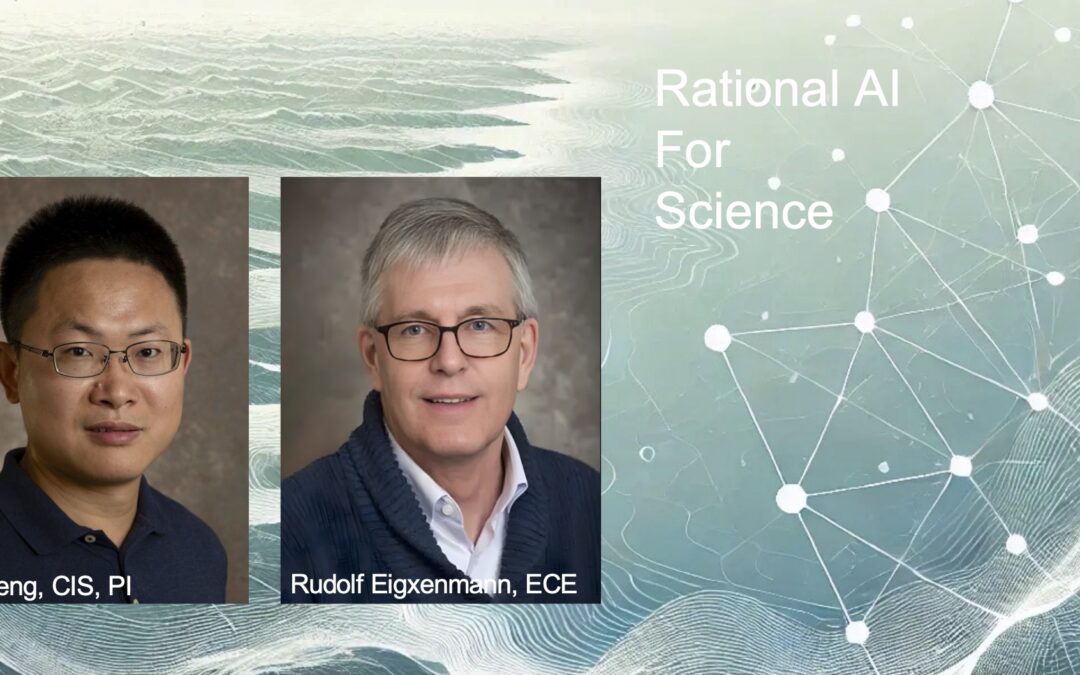Article by Gabrielle London
Beyond Predictions: Dr. Xi Peng develops AI that thinks and reasons like scientists
AI technology. It is powerful, it is analytical, and it is expanding exponentially. The beauty of AI is in its non-humanness—that is, its ability to see and analyze information quickly and with startlingly precise results. However, there are some ways in which we as a society need AI to be human. It must be able to explain itself like a scientist, to be not only accurate but based in real scientific evidence and principle.
Luckily, University of Delaware researcher Xi Peng is spearheading research that seeks to teach AI to do just that. Supported by a $599,000 IIS CORE (Division of Information and Intelligent Systems) award from the National Science Foundation (NSF), Peng is championing the development of brand-new models that take AI data analysis technology a step farther with a necessary characteristic: correctness based in real Science.
The development of modern scientifically rational AI models has been central to Peng’s research aims throughout his whole career. Since 2020, he has dedicated himself to the expansion of this specific project, which seeks to enhance the reliability and accuracy of AI models based on real scientific rules, rationales and evidence. The current field is filled with models which prioritize making accurate predictions over being able to base those predictions on real evidence. Further, the predictions that these models do make are often based on historical scientific data which is static and, therefore, does not reflect the constantly changing world which they are meant to analyze.
Peng is working to overcome this. “We can use AI to help domain scientists only when the model is reliable and safe,” he said. Peng, an assistant professor of computer and information sciences, wants more than results that are just correct—he seeks a future of models that can make accurate predictions and base them in real modern science. “When the AI is safer, then the domain experts are willing to use it because it’s trustworthy,” he explained. “That’s a big deal because people may say ‘AI can do this, can do that, but how? Why can I trust it?’ Especially for some high-stakes safety applications, we need the AI to be more reliable and transparent,” Peng said. To develop these technologies, Peng notes the importance of “double-right predictions.” According to him, these refer to the ability of AI models to make accurate data predictions in two parts: the first is that a model needs to be able to make a correct prediction. When AI models are trained, they learn how to analyze certain types of data distributions.
However, in real-life application, data distributions vary greatly in a way that AI cannot always perfectly understand, and so their accuracy decreases significantly. Through this project, Peng hopes to develop better models that can work through a broad range of Distributions.
The second part of double-right predictions refers to the ability of the AI model to base correct predictions in actual scientific reasoning. In Peng’s research, it is necessary for AI models to be able to “think” like human scientists. The predictions that models make need to be based on real scientific facts, evidence and principles to be trustworthy and reliable to use.
In addition to these two facets, double-right predictions in AI and machine learning models need to be adjusted so that they can maintain scientific accuracy when faced with the constant growth of modern data sets. Current models are not well-equipped to handle vast data sets, which cover a wide variety of scientific fields, data distributions and constantly changing factors like weather patterns. A key part of Peng’s research, then, is focused not only on the development of more accurate double-right predictions, but also on the robustness and efficiency of his AI models.
Peng’s efforts are currently being examined in the context of various projects in different scientific disciplines, including ocean floor mapping and flood water detection. In these scenarios, the new AI models are being tested on their ability to accurately and reliably analyze large and widely varying data sets based on real scientific rationales. For example, with flood water detection, AI models can be used to analyze satellite imaging of expansive land areas that flooding may have affected. However, these models sometimes mistake the shadows of buildings or other structures as flood water. Peng notes that “[AI models] can correctly find the water, but sometimes they may fail, and we don’t know why. So, we want to expand that.” Peng and his team are actively working on advancing the double-correctness abilities in their models as a first step, so that their analyses can be fine-tuned.
The NSF IIS Core Programs award will help fund Peng’s research for three years, until August 2027. He and co-PI Rudolf Eigenmann plan to use the funding to optimize AI models for modern high-performance computing (HPC). This is essential for handling the vast amounts of scientific data, as well as the large-scale AI models required for modern AI4Science research.
Undergraduate students will have an opportunity to work with Peng and Eigenmann through UD’s Vertically Integrated Projects (VIP) program, which allows undergraduate students to participate in ongoing research projects with faculty members. Peng heads the Trustworthy AI Team under the program.
This research will also be presented at the Delaware Advanced Research Workforce and Innovation Network (DARWIN) Computing Symposium, an annual event hosted by UD. This type of community and student involvement will help to create a more inclusive and diverse STEM environment, which is a long-term goal of Peng’s research.
The ultimate goal of Peng’s current project is to create something of a “toolbox” which machine learning and AI researchers can use to build better, more robust models that can accurately predict and explain their analyses with real scientific reasoning. This is an incredibly important innovation in the AI and machine learning fields, and one that has the potential to change all kinds of scientific domains for the better.

